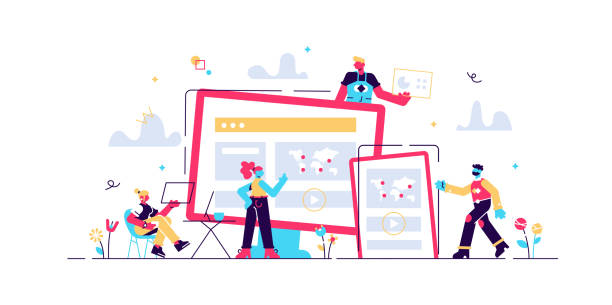Introduction to SEO-Optimized Website Design and Its Importance
In today’s digital world, having a website is just the first step; what’s more important is its visibility among billions of existing pages on the internet.
This is where the concept of SEO-optimized website design comes into play.
#SEO-optimized-website-design means building and optimizing a website that is not only attractive and functional for users but also understandable and rankable by search engines like Google.
This approach ensures that your website ranks higher in search results relevant to your business or content, attracting more organic (free) traffic.
The importance of this process goes beyond merely increasing visitors; an SEO-structured site is, literally, a bridge between your business and potential customers.
Without adhering to SEO principles in the initial design stages, your website might never reach its full potential and could get lost in the vast sea of information.
This is a long-term investment that yields significant returns.
Optimizing a website for search engines is a continuous process that requires technical knowledge, understanding user behavior, and familiarity with Google’s algorithms.
A deep understanding of these principles helps you build a website that is not only beautiful and efficient but also capable of competing in the online space.
Do you dream of a thriving online store but don’t know where to start?
RasaWeb is your comprehensive solution for e-commerce website design.
✅ Attractive and user-friendly design
✅ Increased sales and revenue⚡ Get free consultation
Key Elements in Designing a Search Engine Optimized Website
SEO-optimized website design involves a set of technical and content elements that must be carefully observed.
Technically, site loading speed is one of the most critical factors; a site that loads slowly not only drives users away but also receives negative points from Google’s perspective.
Image optimization, caching, and choosing suitable hosting are among the important measures in this regard.
Furthermore, website responsiveness, meaning its compatibility with various devices (mobile, tablet, desktop), is crucial for SEO, as a large portion of searches today are performed via mobile devices.
Friendly URL structures, using SSL certificates for security (HTTPS), and a logical information architecture that facilitates navigation for users and search engine crawlers are other important technical aspects.
From a content perspective, producing high-quality, unique, and relevant content aligned with target keywords plays a fundamental role in attracting organic traffic.
Proper use of headings (H1, H2, H3), Meta Descriptions, and Alt Text for images helps search engines better understand your page content.
Every component in the SEO-centric website design process is a puzzle piece that contributes to your website’s visibility and success.
Without a proper understanding and implementation of these elements, your efforts for an online presence might remain fruitless.
The Role of Keyword Research and Quality Content in Website SEO
One of the main pillars of SEO-optimized website design is keyword research.
Keywords are phrases that users enter into search engines, and your website must be aligned with these words to appear in the results.
This process goes beyond guesswork and requires precise analysis of competitors, search volume, and the relevance of keywords to your business.
Using tools like Google Keyword Planner, SEMrush, or Ahrefs can be very helpful in this regard.
After identifying suitable keywords, it’s time to produce high-quality and engaging content.
Content should not only include target keywords but also provide useful, accurate, and unique information to the user.
Longer and more comprehensive content usually performs better in SEO, provided its quality and value are maintained.
Thought-provoking content that encourages user engagement, or educational and guiding content that solves a specific problem, can keep users on your site longer and send positive signals to Google.
Technical Aspects of Building an SEO-Centric Website
Technical aspects in SEO-optimized website design are as important as content and keywords.
One of the most important factors is page loading speed.
Google gives higher scores to websites that load faster because they provide a better user experience.
Tools like Google PageSpeed Insights can help you identify problems and optimize speed.
Optimizing images (reducing size without compromising quality), compressing code (HTML, CSS, JavaScript), and using Content Delivery Networks (CDNs) are effective methods for increasing speed.
Furthermore, a friendly URL structure that is short, descriptive, and includes keywords helps search engines understand page content.
Using an SSL certificate (HTTPS) for website security not only helps protect user data but also acts as a ranking factor in Google.
The website should be responsive, meaning it automatically adjusts to the user’s device screen size.
This feature is crucial for mobile SEO, which accounts for a large portion of search traffic.
Using structured data (Schema Markup) can also help search engines better understand your content and display it in a richer way in search results.
These technical details might seem complex at first, but they are essential for a fully SEO-centric website design.
Do you have an online store, but your sales aren’t as you expect? RasaWeb solves your problem permanently with professional e-commerce website designs!
✅ Significant increase in conversion rates and sales
✅ Unparalleled user experience for your customers
⚡ Click to get a free consultation with RasaWeb!
The Impact of User Experience (UX) on Website Optimization for SEO
At first glance, User Experience (UX) and SEO might seem like separate fields, but in reality, they are closely intertwined.
An SEO-optimized website design isn’t just about appealing to search engines, but also about providing the best possible experience to users.
Google is increasingly paying attention to UX-related factors such as Bounce Rate, Dwell Time, and Click-Through Rate (CTR) as ranking factors.
If users enter your site and quickly leave (high bounce rate), this sends a negative signal to Google that your content was not engaging or useful to the user.
Conversely, if users spend a significant amount of time on your site and view various pages, this indicates their satisfaction and the value of your content.
Easy navigation, attractive and clean visual design, high readability, and clear Call-to-Action (CTA) buttons all contribute to improving the user experience.
Also, reducing intrusive ads and pop-ups that can disrupt the user experience is very important.
Website optimization for SEO should always be done with the end-user in mind; a site that users like and find easy to use will naturally perform better in search engines as well.
A website with eye-catching visual design and intuitive navigation not only attracts users but also signals to search engines that it has valuable content to display.
The Importance of Link Building in SEO-Oriented Website Design
Link building, both internal and external, plays a crucial role in SEO-optimized website design.
Internal links demonstrate the connection between different pages of your website and help search engines better understand your site’s structure and transfer link equity between pages.
Strategic use of internal links can improve crawl rate and user dwell time.
On the other hand, external links or Backlinks, which point from other reputable sites to your website, are considered “votes of confidence” by Google.
The greater the number and quality of backlinks, the higher your site’s credibility and authority (Domain Authority) in Google’s eyes, and your ranking chances increase.
However, the important point is that quality takes precedence over quantity; a single link from a reputable and relevant site is worth far more than dozens of links from low-quality or spammy sites.
Link-building strategy should be natural and ethical, avoiding black-hat SEO techniques (like buying links), as this can lead to penalties from Google.
Creating engaging and shareable content can naturally attract backlinks.
Participating in relevant online forums, publishing guest posts on other blogs, and digital public relations are also effective ways for link building that significantly contribute to the success of an SEO-optimized website.
Analytical Tools and Performance Monitoring in Website SEO
After implementing the principles of SEO-optimized website design, the next step is performance monitoring and analysis.
SEO is not a static process and requires continuous monitoring and optimization.
Various analytical tools are available to help you evaluate your website’s performance in search engines.
Google Analytics is one of the most powerful tools, providing comprehensive and accurate information about site traffic, user behavior, traffic sources, and conversion rates.
Using this data, you can identify your site’s strengths and weaknesses and adjust optimization strategies.
Google Search Console (formerly Google Webmaster Tools) is also an essential tool that allows you to view your site’s performance in Google search results.
This tool shows crawling issues, server errors, incoming and outgoing links, and keywords users have used to find your site.
Additionally, paid tools like SEMrush, Ahrefs, and Moz offer more advanced features for keyword research, competitor analysis, rank tracking, and backlink profile examination.
Precise analysis of this data helps you make informed decisions for continuous improvement of your website’s SEO and ensures that your website is always on the path to SEO success.
These tools are essential for anyone looking for a professional and SEO-optimized website design.
Common Mistakes in Building an Optimized Website and How to Avoid Them
In the journey of SEO-optimized website design, common mistakes can harm your site’s ranking in search engines.
One such mistake is neglecting SEO in the early design stages.
SEO should not be added after the website design is complete; rather, it should be woven into the fabric of the design from the outset.
Another mistake is excessive use of keywords (Keyword Stuffing), which not only disrupts the user experience but is also identified by Google as a spam technique and can lead to penalties.
Duplicate or copied content from other sites also severely harms SEO; Google rewards unique and valuable content.
Lack of mobile optimization, given the high volume of mobile searches, is a major mistake that should not be overlooked.
Additionally, slow site speed, broken links, and the absence of an XML Sitemap and robots.txt file are issues that can hinder your site’s crawling and indexing.
Failure to update content and ignoring changes in Google’s algorithms can also lead to rank loss.
To avoid these mistakes, it is essential to adopt a comprehensive and analytical approach to SEO-centric website design, continuously monitor the site, and keep pace with Google’s latest recommendations and algorithms.
Does your current corporate website accurately represent your brand and attract new customers?
If not, turn this challenge into an opportunity with RasaWeb’s professional corporate website design services.
✅ Significantly enhances your brand’s credibility and image.
✅ Paves the way for attracting new leads and customers.
⚡ For a free and expert consultation, contact RasaWeb now!
The Future of SEO-Focused Website Design and Trends
SEO-optimized website design is constantly evolving, and with each Google algorithm update, methods and priorities change.
In recent years, we have witnessed an increasing importance of voice search; optimizing content to answer conversational and long-tail keywords has become more crucial.
Artificial intelligence and machine learning also play a more prominent role in search engines’ understanding of content and user intent.
Algorithms like Google BERT and RankBrain indicate this trend.
Page Experience, which includes Core Web Vitals (loading speed, interactivity, and visual stability), has been introduced as an official ranking factor, emphasizing the importance of UX in SEO.
Visual and video content is also increasingly popular, and optimizing them for SEO (such as using captions, alt tags, and proper video structuring) has become especially important.
Furthermore, the concept of E-A-T (Expertise, Authoritativeness, Trustworthiness) has become vital, especially for websites in health, finance, and legal fields.
These trends indicate that SEO-optimized website design will increasingly move towards quality, user experience, and a deeper semantic understanding of content in the future.
Conclusion: A Comprehensive Guide to SEO-Oriented Website Design
In conclusion, SEO-optimized website design is more than just a technique or a set of tips; it’s a comprehensive philosophy for building a successful and sustainable online presence.
From the very beginning of site design and architecture, every decision should be made with SEO goals and user experience in mind.
From precise keyword selection and valuable content creation to technical optimizations like site speed and mobile-friendliness, as well as smart link-building strategies, all are vital components of this puzzle.
Analytical tools allow us to measure our performance and continuously improve.
By considering common mistakes and avoiding them, potential obstacles can be prevented.
The future of SEO, with trends such as voice search, artificial intelligence, and the increasing importance of page experience, promises exciting changes that require continuous updates and adaptation.
Investing in SEO-optimized website design not only means attracting more traffic but also building a strong brand, increasing credibility, and ultimately achieving business goals in the competitive digital space.
This is a rewarding path that comes to fruition with patience, knowledge, and continuous effort.
Frequently Asked Questions
| Question | Answer |
|---|---|
| What does SEO-optimized website design mean? | It means designing a website that, in addition to an attractive appearance, is technically and content-wise optimized to achieve a higher ranking in search engine results. |
| Why is SEO-optimized website design important? | It increases organic traffic from search engines, improves business visibility, attracts more customers, and ultimately boosts sales. |
| What are the key elements in SEO-optimized website design? | Mobile optimization, fast loading speed, high-quality and relevant content, proper use of keywords, appropriate URL structure, and utilization of title and meta tags. |
| What role does content play in website SEO? | Unique, valuable, informative content with target keywords plays a vital role in attracting users and achieving better search results rankings. |
| What is Mobile-First Indexing? | It is a Google approach where the mobile version of a website is prioritized for indexing and ranking. Therefore, website responsiveness for mobile is essential. |
| How can site loading speed be improved? | By compressing images, using caching, optimizing CSS and JavaScript codes, utilizing powerful hosting, and enabling Gzip compression. |
| What is the importance of keywords in SEO? | Keywords help search engines understand your page’s topic and connect it to relevant user searches. |
| What role do Title Tags and Meta Descriptions play? | The title tag is the most important element in on-page SEO, and the meta description is a summary of the page’s content that encourages users to click. Both are displayed in search results. |
| How does Internal Linking help with SEO? | It helps search engines discover and index various pages of the site and distributes page value across different sections of the site. It also improves user experience. |
| What is the use of a Sitemap in SEO? | It is an XML file that provides a list of all important pages on the site to search engines to facilitate site crawling and indexing. |
And other advertising agency services by RasaWeb in the field of advertising
How to use competitor analysis to improve online advertising for ventilation manufacturers
Investigating the impact of live video advertising on the sales of ventilation equipment manufacturers
The role of personalized advertising in attracting customers for ventilation equipment manufacturers
How to use integrated advertising for ventilation manufacturers
Investigating the impact of influencer advertising on the sales of ventilation equipment manufacturers
And over hundreds of other services in the fields of online advertising, advertising consultation, and organizational solutions
Online Advertising | Advertising Strategy | Advertorials
🚀 RasaWeb Afarin Digital Marketing Agency, specializing in boosting your business by providing comprehensive SEO services, targeted advertising, and professional website design.
📍 Tehran, Mirdamad Street, next to Bank Markazi, Southern Kazeroon Alley, Ramin Alley, No. 6



